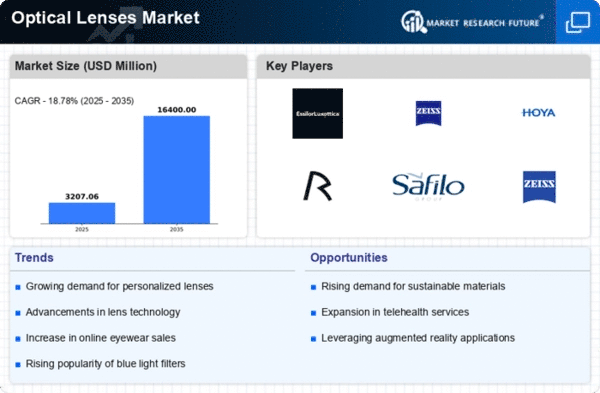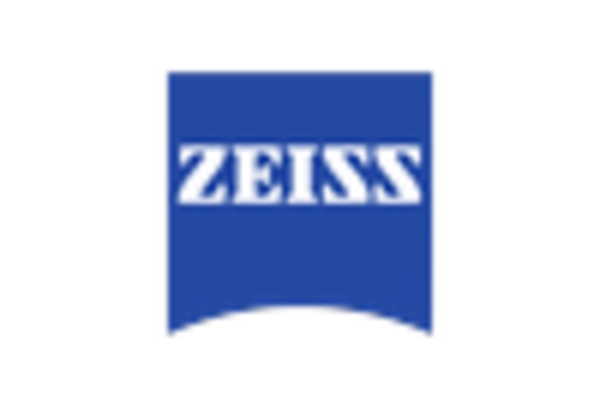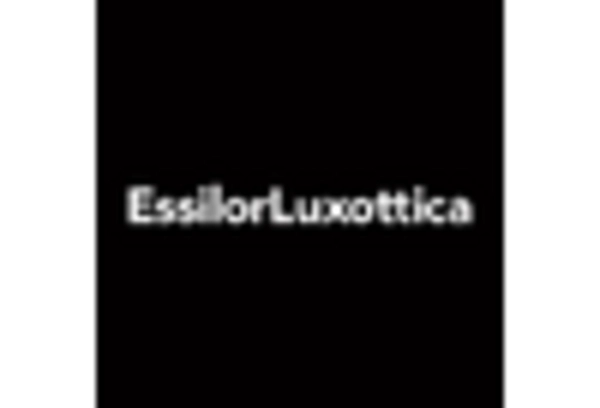Market Analysis
Optical Lenses Market (Global, 2024)
Introduction
Optical lenses are about to experience considerable change. This will be brought about by technological developments, an increasing demand for quality vision correction, and a growing prevalence of vision-related disorders. As the population ages and digital device use rises, the need for optical products that enhance visual clarity and comfort will become ever more important. In the meantime, the applications of optical lenses are varied: spectacles, contact lenses, and special lenses for professional and leisure activities. The integration of smart and personalised lens solutions is also reshaping consumers’ expectations and bringing about a shift in R&D to meet these changing needs. The market is characterised by a mixture of established players and newcomers that are all striving to gain market share by differentiating their products and forging strategic alliances. As the industry navigates these shifting dynamics, a clear understanding of the trends in consumer demand and technological advancements will be essential for the success of all players.
PESTLE Analysis
- Political
- The market for spectacle lenses will be influenced by many political factors in 2024, including government legislation relating to health care and eye care. For example, the U.S. government has allotted $ 1.5 billion for the improvement of access to eye care under the Affordable Care Act. This is expected to increase demand for spectacle lenses. In addition, the trade policy and tariffs on imported optical materials have been changed, and the U.S. has imposed a tariff of 25 per cent on certain optical products from certain countries, which will affect the market price and availability.
- Economic
- The economic framework for the 2024 ophthalmic lenses market is determined by the spending patterns and disposable income of consumers. According to recent data, the average expenditure on health care, including eye care, has risen to $ 4,500 per year, a rise of 10% over the previous year. This shows the growing concern for eye health and the willingness to spend on quality ophthalmic products. The unemployment rate in the United States has stabilized at a low of 3.8%. This has boosted consumer confidence and spending on ophthalmic products.
- Social
- Among the social phenomena that are affecting the market for optical lenses is the rising trend of digital eye strain, which is caused by long hours in front of a screen. In 2024, a survey was conducted which showed that 70 per cent of adults are experiencing symptoms of digital eye strain. This has resulted in an increased demand for specialized lenses, especially those that block blue light. The aging of the population is also driving the demand for corrective lenses. By 2035, the number of people over the age of 65 is expected to reach 78 million. This will lead to a further increase in the importance of vision care in society.
- Technological
- The spectacles market is being revolutionized by the technological development of lenses. By 2024 the introduction of 3D printing has brought the cost of lens production down by around 15 per cent and has made it possible to produce lenses in a much greater variety of shapes and colours. The integration of augmented reality features in lenses is gaining ground and this year it is estimated that around five million AR lenses will be sold. These technological developments are making it possible to produce lenses with new functions and new properties, and a new generation of customers is demanding these developments.
- Legal
- In 2024, the market for eyeglasses will be influenced by legal factors, such as strict regulations on product safety and quality standards. The FDA has introduced new regulations requiring all manufacturers of optical lenses to conform to the ISO 13485 standard for quality management systems for medical devices. The more than 1,200 manufacturers operating in the U.S. market are required to comply with these regulations to ensure that consumers receive safe and effective products. Intellectual property rights are also increasingly important. In the past year, more than 500 patents were filed in the field of optical lenses.
- Environmental
- The growing importance of the environment in the production of optical lenses, particularly in terms of sustainable manufacturing practices, is a trend that is beginning to be felt in the market. By 2024, approximately thirty per cent of optical lens manufacturers will have used eco-friendly materials, such as biodegradable plastics, in their production processes. In addition, a recent survey has shown that sixty-five per cent of consumers prefer brands that are committed to the environment. Furthermore, waste management regulations are becoming increasingly strict, and the European Union has passed a directive requiring the manufacturers of optical products to take part in the recovery and re-use of these products.
Porter's Five Forces
- Threat of New Entrants
- The market for spectacles has medium-sized barriers to entry, requiring a large investment in technology and production. The market is characterized by strong brand loyalty and brand recognition, which deters new entrants. The growing importance of e-commerce and the technological development may, however, open up new opportunities for new players to enter the market.
- Bargaining Power of Suppliers
- The bargaining power of suppliers in the market for optical lenses is relatively low because of the many suppliers and the commodity nature of the raw materials used in lens manufacture. Suppliers can easily be replaced by other suppliers if prices rise, which limits their power. Also, many companies have diversified vertically to reduce their dependence on suppliers.
- Bargaining Power of Buyers
- The buyers of the optical lenses market have high bargaining power because of the availability of many substitutes and the low switching costs associated with changing brands. Also, the consumers are very informed and sensitive to price, resulting in a price war. Retailers exert significant influence on the suppliers, thereby enhancing buyer power even further.
- Threat of Substitutes
- The threat of substitutes in the market for optical lenses is moderate. Competition is provided by contact lenses and corrective surgery, but the unique advantages of optical lenses such as prescription and coatings limit the threat of substitutes. Nevertheless, innovation in alternative methods of correcting vision may increase this threat over time.
- Competitive Rivalry
- The market for lenses is highly competitive. There are many players trying to take a share of the market. Competition is based on factors such as price, quality, innovation and customer service. Brands with a long history and new entrants compete with one another, and this competition leads to aggressive marketing and continuous product development.
SWOT Analysis
Strengths
- Growing demand for corrective eyewear due to increasing prevalence of vision disorders.
- Technological advancements leading to improved lens quality and customization options.
- Strong brand loyalty among consumers for established optical lens manufacturers.
Weaknesses
- High production costs associated with advanced lens technologies.
- Limited awareness and accessibility in emerging markets.
- Dependence on a few key suppliers for raw materials.
Opportunities
- Expansion into emerging markets with rising disposable incomes.
- Increasing adoption of online retail channels for optical products.
- Potential for innovation in smart lenses and augmented reality applications.
Threats
- Intense competition from low-cost manufacturers and alternative vision correction solutions.
- Economic downturns affecting consumer spending on non-essential items.
- Regulatory challenges and changes in healthcare policies impacting the optical industry.
Summary
Optical Lenses Market is characterized by strong demand, which is driven by the growing vision disorders and technological advancements. The market is hampered by the high cost of production and the lack of market penetration. The opportunities for growth lie in the emerging markets and e-commerce. The threats come from competition and economic fluctuations. The focus on innovation and market penetration will be the main strategy for utilizing the strengths and avoiding the risks.
















Leave a Comment